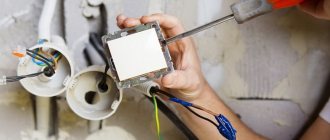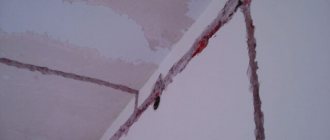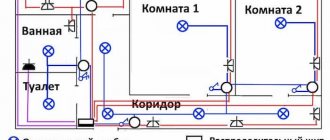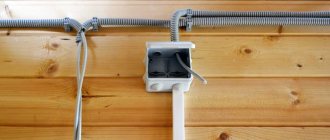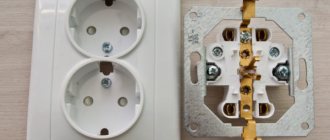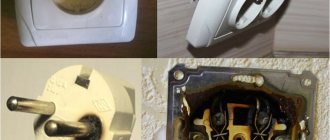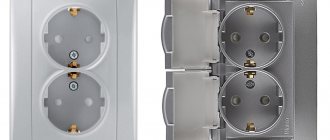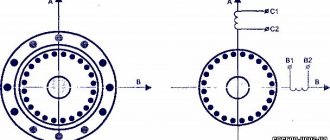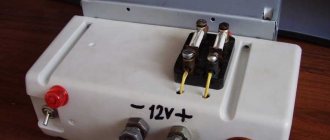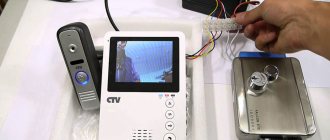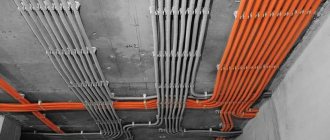Until recently, electrical wiring in a private house was made of aluminum cable with a cross-section of 2.5 mm². And this was more than enough to connect a refrigerator, iron or radio.
However, time does not cost less, and every day the number of household appliances in the house only increases (air conditioners, electric stoves and ovens, boilers, autonomous heating boilers, and so on). In this regard, the load on the electrical wiring increases significantly, which can lead to its failure, followed by a short circuit or even a fire.
For this reason, during new construction or renovation work, it is first necessary to carry out new installation of electrical wiring in a private house. To do this, you can either order the services of professionals, or do all the work yourself.
In the second case, it will be extremely useful to read this article, since it will describe in detail each of the stages of electrical installation and present all the basic requirements, recommendations and limitations when performing this type of work.
Calculations and diagram
First, you need to draw a wiring diagram for your apartment . To do this, you don’t need to be an engineer, because you don’t need a complicated linear diagram according to GOST. It is enough to draw a schematic drawing by hand. An electrical wiring diagram is needed in order to correctly distribute the cable throughout the apartment, and calculate its approximate amount, as well as determine the load on each future line.
Electrical wiring diagram
Draw where you will have sockets and switches. At the same time, take into account what household electrical appliances you will include in them, how many and what kind of lamps you will use.
It is not recommended to hang more than 8-10 sockets on one line. Since all sockets in the line are pass-through, with each subsequent socket there is a possibility of weakening the contact. Especially do not make many sockets on one busy line, for example in the kitchen; it is better not to save money and extend two lines to the kitchen.
Determine the required number of lines and the expected load on them. It is better to divide the lines into zones, for example: kitchen sockets, corridor sockets, bathroom sockets, room 1 sockets, lighting, etc.
Installation and assembly of the distribution panel
After laying cables and wires, installing and connecting distribution boxes, you can begin installing the electrical distribution panel.
How many modules should the shield be installed on?
Electrical wiring in a private house involves installing a panel on each floor in private houses, cottages or dachas. However, in order to find out how many modules are needed, you first need to calculate how many consumers there will be. Let's make a calculation for the standard version, that using its example we were able to install electrical wiring in the house with our own hands.
Let's say on your floor:
- 3 rooms.
- Kitchen;
- Corridor;
- Boiler;
- Washing machine;
- Warm floor system in 3 rooms and kitchen;
- Electric stove;
- 4 air conditioners.
Based on this, you need to install in the distribution board:
- 5 single-pole circuit breakers 10 A (lighting 3 rooms, kitchen and corridor);
- 14 pieces of RCD for 16 A (3 pieces of sockets in rooms, 1 piece of kitchen sockets, 1 piece of corridor sockets, 1 piece of boiler socket, 1 piece of washing machine socket, 3 pieces of floor heating system, 4 pieces of air conditioning);
- 1 RCD 25–32 A for connecting an electric stove.
From the above calculations, we will have 35 occupied modules (30 modules occupy 15 RCDs and 5 circuit breaker modules). That is, we will need a distribution board with 36 modules. However, if you also want to connect a voltage limiter or the number of consumers will be larger, then the shield must be mounted on 48 modules.
After installing the distribution board, you can install RCDs and circuit breakers. They are easily mounted on a special DIN rail, which comes as standard with the switchboard.
Important! When disconnecting the distribution board, the phase (brown) wires must go through automatic machines or RCDs, the neutral (blue) wires must be collected on the zero bus, and the yellow-green wires must also be connected on the 2nd zero bus).
Cable selection
In order for electrical appliances to operate without overloading the network, the cable of each line must be of the appropriate cross-section. And if there are several consumers on the same line (for example, to the kitchen) (and there will be), then it is necessary to calculate their total power and leave a margin of “strength” for the cable , that is, select the required cross-section (wire thickness). The power of all household appliances is always indicated by the manufacturer. For example: an incandescent lamp is 40W, and a hob is 6000W, etc.
In order not to bother with calculations, follow one simple rule. — For outlet lines, use a copper cable with a cross-section of 2.5 sq. mm, for all lighting 1.5 sq. mm, and for a hob or instantaneous water heater 4 sq. mm - and everything will be fine!
| Wire cross-section (sq.mm) | Current (A) | Power, W) | Machine denomination |
| 1,5 | 15 | 3300 | 16 |
| 2,5 | 21 | 4600 | 20 |
| 4 | 27 | 5900 | 25 |
| 6 | 34 | 7400 | 32 |
Each device (consumer) has its own declared maximum power, measured in Watts.
Simplified power formula
The cable must be three-core (phase, neutral, ground). Zero is always blue, ground is yellow or yellow-green, phase is any other color . If you change the wiring, do not skimp on the material - always take a cable with a third core (with grounding), because all modern devices have an additional protective terminal, and automatic protection works only using grounding .
To replace electrical wiring, it is best to use a VVG-ng cable. You can, of course, use NYM or PVS, but the advantages of the VVG cable over others are obvious. Firstly, VVG does not need to be crimped with sleeves (soft ones need to be crimped). And secondly, it is smaller and flat, which allows you to make smaller grooves, and it is possible to insert the cable into a thin slot (3mm for a three-core cable with a cross-section of 1.5mm)
Uncrimped wire with sleeve
Always take only cable in accordance with GOST! For example, an excellent cable is the Gostov VVG ng cable. This is a very important point in preparing to replace the wiring! You can save on automation or sockets (they can always be replaced), but don’t skimp on the cable - get a good one.
Safety regulations
When installing wiring in the house with your own hands and connecting electrical equipment, it is very important not to forget about the notorious safety precautions. Everyone has heard about this 100 times, but that is no reason to take it lightly. The most precious thing - your health and even life - depends on how careful you are.
Power cable brand ASB - characteristics, classification and rating of the best manufacturers. 115 photos and video instructions for choosingRetro wiring in a wooden house: calculation of parameters, design, installation and selection of vintage elements. 165 photos of stylish ideas
Heating cable for gutters and roofs: choosing and installing a self-regulating anti-icing heater with your own hands (135 photos + video instructions)
Marking
Determine at what height the sockets and switches will be located; the easiest way is to measure the lines of sockets and switches from the ceiling, because the floors in apartments are most often crooked. For example, if the height from floor to ceiling after renovation will be 250 cm, and you want to raise the sockets by 30 cm, measure 220 cm from the ceiling. If there are several sockets and switches in one group, draw a horizontal line along the level and place a mark every 7 cm (socket box size 71mm), the same applies to vertical groups.
For lovers of standards, so that it is “like everyone else” or “how they do it” - remember, they do not exist! There are requirements for children's institutions, kindergartens and schools, where sockets and switches are installed at a height of at least 160 cm . Everything else, especially in your home, you can do as you please. For example, some make sockets in window slopes or even in the floor.
Basic Rules
Wiring in an apartment or house is carried out only in accordance with the PUE. But, despite the apparent severity, most of the basic rules for installing electrical wiring are not so difficult to follow. Here is a short list of them:
- during installation, convenient access to all the main elements of electrical wiring must be provided - circuit breakers, RCDs, sockets, switches and distribution boxes (boxes must not be tightly walled up);
- the installation height of the switch is from 60 to 150 cm from the floor, the installation location is on the opposite side from the one where the door opens;
- electrical wiring must be laid only vertically or horizontally; diagonal or free bending is not permitted;
- the socket is installed at a height of 30 cm (European standard) to 80 cm (accepted in Russia for safety during flooding) from the floor;
- the distance from the outlet to the gas or electric stove, heating radiator and any pipes is at least half a meter;
- The horizontal electrical wiring line is mounted no closer than 15 cm to the ceiling or floor, vertical - no closer than 10 cm to the edge of the door or window;
- the distance between parallel cables is at least 3 mm, or each cable must be in a protective casing (corrugated or armored pipe);
Cable installation should only be on terminals inside distribution boxes (socket boxes can play their role). The connection of cores by twisting, wrapped with electrical tape, is unacceptable.
As a last resort, the twist should be soldered and insulated using cambric - heat-shrinkable tubing. Be sure to take care of grounding. If it was not there, it must be mounted and connected to the common bus with a bolted connection.
Preparing for gating
Typically, wiring in apartments is carried out either on the floor or on the ceiling. There are other options, such as laying cables under baseboards or ducts.
Lighting lines, in any case, are laid behind a suspended or suspended ceiling; if these are not planned, then the ceiling needs to be chipped. And since it is strictly forbidden to ditch , you need to apply a layer of plaster to the ceiling, which will allow you to hide the cable without damaging the monolith. We strongly do not recommend ditching the ceiling yourself, since you need to know the technology for correct gating so that the whole house doesn’t collapse someday.
In cases where plastering of the ceiling is not planned, experienced craftsmen find voids in the monolith slab with the old cable, and tighten a new one in its place.
Using a 70mm or 68mm concrete crown (attachment for a hammer drill), holes for the socket boxes are drilled. Using a wall chaser or grinder, grooves are cut out for laying the cable. The grooves in the walls must be strictly vertical and not horizontal or diagonal. The lines from the sockets to the panel are laid in the floor screed or along the ceiling.
If the ceilings are not wooden, then according to the PUE (electrician's bible), cable laying without corrugation is allowed! There is also no need for a corrugated floor screed; the most important thing is a high-quality cable with good insulation in accordance with GOST! Save on corrugation; if you don’t have drywall or wood (or other flammable materials), then you don’t need corrugation!
A detailed description of the correct cutting of holes for socket boxes. Why can you lay cable without corrugation?
What is the usual wiring diagram in a private home?
Of course, houses can be very different from each other, but the essence of high-quality installation is approximately the same for everyone, and it is as follows:
- An electric meter is installed on the facade of the building, to which a descent is made from the overhead line via a self-supporting insulated wire (the electricity supply organization is responsible for this part and for the meter).
- A voltage stabilizer(s) and a power distribution panel or automation are installed in a garage or some other room, which controls and transmits electricity through an input copper cable with a cross-section of 10–35 mm².
- A generator is installed on the street near the room where the switchboard is located, which supplies the house in the absence of a centralized power supply.
- On each floor inside the house there is a separate distribution panel, to which the input cable is connected in parallel.
- The distribution panel contains separate RCDs for the sockets of each room, circuit breakers separately for each room and separate RCDs for air conditioners, boilers, heating boilers and underfloor heating systems.
- All powerful consumers are powered strictly from the distribution panel, which provides for the installation of individual protection elements (RCD).
- A separate distribution box must be installed in each room, in which the input cables and cabling and wiring products of the socket group and lighting circuits will then be switched.
Important! When drawing up a power supply plan, it is necessary to take into account the type of supply network. If you have a 3-phase network, then the input cable to the house should have 5 mils; in the case of single-phase power supply, the number of cores of the supply cable should be 3.
Once you have decided on the power supply circuit and installation locations for electrical accessories, you can begin marking out the room.
Grilling
Before you start dabbling, it is highly advisable that the walls and ceilings be plastered with a leveling layer of plaster. Firstly, you will not have further problems with the final installation of sockets, since all the sockets will be flush with the wall, and not recessed into it (which happens when they are installed before the walls are plastered). And secondly, gating will occur much faster, since in some places it will not be necessary to saw the monolith.
Check in advance the places where you will be trenching so as not to touch communications, such as old wiring and plumbing pipes. If you cannot determine where the old wiring goes, call an electrician , or simply disconnect it in the switchboard (if you are going to change it all). For ease of work, make yourself a temporary carrier (extension).
The hole for the socket boxes is drilled to the full depth of the crown. To quickly drill a hole in concrete, mark a circle with a crown, then drill the maximum possible number of holes around the circumference with any drill, no less than the depth of the crown. After which, the cutting with a crown will go noticeably faster, one might say – it will go like clockwork. If it gets on the reinforcement, it is best to use another crown; in extreme cases, you can knock it off with a spatula. It’s better to use a hammer drill for help (don’t forget about neighbors and the police).
Cost of installation of one electrical point
The cost of installing electric points is calculated based on several conditions. The cost of work depends on:
- From the method of wiring. With hidden lines, you have to cut or chisel niches and fix the mechanism in the sockets. Such work will cost more than open-cut installation.
- From the material of the walls. To make nests in concrete and brick, professional tools and attachments are used; the cost of installing an electric point in dense walls is higher.
You can see approximate prices in the price list on our website. We announce the full cost immediately after completing the calculations before starting work on installing the electrical point, the price does not change, we have no hidden overpayments.
Call +7 (495) 133-65-32, we can order the installation of additional electrical points, complete replacement and installation of electrical equipment at a new facility from scratch. We employ specialists with significant experience, specialized education and corresponding electrical safety clearance groups. The quality of electrical installation work is carefully monitored on site. The service comes with a long-term guarantee. All details can be clarified when contacting.
Working with a wall chaser or grinder
Grooves for laying cables go from the socket box to the floor or ceiling. You need to lower the groove down so that the cable lies quietly in the screed and does not stick out in the corner, so you need to know the thickness of the future screed, the same with ceilings. It is best to have a wall chaser with a vacuum cleaner for these tasks, but in extreme cases you can get by with a grinder and a diamond disc for stone. In the case of an angle grinder, take care of your health, wear a respirator and goggles. Close all windows and doors to prevent dust from entering adjacent rooms.
How does a closed gasket go?
Installation of hidden electrical wiring is carried out according to the following algorithm.
First, using a level, pencils or markers, mark the wall, determining the lines for laying the cables. In this case, the presence of previous wiring is checked using a special tester. Before installation, the points for inserting sockets, switches, installing lamps, distribution boxes - right up to the panel - are also marked on the wall before installation.
Using an impact drill or a hammer drill with a crown attachment, niches for sockets and switches are cut out in the marked places.
After this, using a grinder, a hammer drill with a chisel attachment or a hammer (in hard-to-reach places), grooves are cut strictly along the marking lines for laying cables. The depth of the groove is about 2 cm.
The wires are laid (they can be lightly “grabbed” with alabaster), socket boxes and distribution boxes are installed.
The first is the main wire VVG 3*2.5 (or NYM 3*2.5). It fits into the groove of the main line - from the socket boxes to the distribution boxes, and from them to the main panel. In distribution boxes, lighting cables with a cross-section of 1.5 are connected to it using terminals.
Installation of an electrical wiring line for heavy loads with a cross-section of 4 mm (electric stove, boiler) is carried out only in a separate line.
The socket boxes are planted on a gypsum mixture. After installing all electrical wiring lines, the entire system is tested with a tester. If no errors are found, then you can proceed to finishing the grooves with plaster and installing sockets and switches.
Cabling
Laying the cable on the floor is not difficult; it is enough to hold it to the floor in any way so that it does not float up when they make the screed. Usually they lay the cable along the walls (at a distance of 10-15 cm from the wall) so that later they know exactly where the cable goes.
It is worth noting that it is better not to lay cables under doorways! To lay the cable along the floor, it is better to make through holes between the rooms. Otherwise, there is a possibility of damaging the cable when installing the interior thresholds.
Laying the cable in the groove is also not particularly difficult. You can secure the cable in the groove using dowel clamps or ordinary alabaster (construction plaster). Alabaster hardens quickly, so it is also convenient to use for installing socket boxes. But before you smear the grooves with it, you need to remove dust from them and moisten them with water.
If the cable is securely fastened in the groove and does not stick out anywhere, the grooves can be covered with ordinary plaster mixture; this will save a lot of time.
How to install socket boxes correctly is written in detail here
Installation of hidden electrical wiring
This wiring installation option is actively used in our country. It is suitable for rooms made of monolithic stone, natural or artificial stone, as well as brick.
To lay the cable in the walls, you need to make a special channel (groove). The grooves are pre-cut along the marked route, and at the end of the work they are covered with plaster.
At the location of each regulatory element, you need to make a recess approximately 6 centimeters deep. To calculate the exact depth, the dimensions of the box are required. Place the devices in the recesses and secure them with mortar.
Despite its popularity, hidden wiring has a number of disadvantages. The main disadvantage is the need to destroy the walls in case of breakage. But if you take a responsible approach to the installation and further operation of the devices, repairs will not be needed for many years. A significant advantage of a hidden system is its neat appearance.
About junction boxes
Junction boxes (or distribution boxes) are necessary for switching (connecting) wires in them and branching lines, for example, for a switch.
Today, professional electricians will tell you that there is no need to install junction boxes in existing apartments ! They can play a cruel joke on your wiring. In the event of a short circuit, tearing, flooded neighbors, etc., you will need access to this very junction box. It’s easy to give up junction boxes - do all the switching in the socket boxes! To do this, you need DEEP socket boxes , in which all switching for lighting will take place. Typically, deep socket boxes are made for light switches, but if switching is needed to branch out socket lines, then deep socket boxes are also installed under the sockets.
Wiring from scratch
Wiring begins by creating a wiring diagram with your own hands and calculating the required amount of materials. After this, they begin to prepare the walls according to the drawn up plan. Markings are initially made on the wall, along which recesses are created for laying the wire.
The installed cable must be secured with brackets. After the cable route has been laid, they begin to install switches, sockets and boxes. When everything is done, the shield is assembled and the entire system is tested.
Electrical panel installation
The most budget option is to install all the circuit breakers on the staircase in a common panel, where your old circuit breakers and meter are already located. To do this, it is necessary to route all the cables into the access panel. If you want a shield in your apartment, then you need to choose a suitable place for it.
Built-in or overhead shield is up to you. The built-in one looks more aesthetically pleasing, but the overhead one is easier to install. All lines from the apartment go to the panel, and from it one thick cable goes to the entrance panel, the cross-section of such a cable must be at least 6 mm, that is, a three-core cable, for example VVG 3 * 6.
Network current strength
It is important to calculate the current strength that will flow to the network in order to select machines and cable cross-sections. Sum up the power of all electrical equipment used and divide by 220 V.
You will get the maximum current that occurs when connecting all devices. Based on this parameter, select the cross-section and protective devices.
Installation of circuit breakers
Each individual line is equipped with its own circuit breaker, with a rating depending on the cable cross-section. According to the rules, you cannot insert more than two lines into one machine; if you are trying to power more than three lines from one machine, you must install a special branching bus.
Today there are many ways to protect electrical wiring, even at the household level. The most necessary condition is the installation of circuit breakers for protection against overloads and short-circuit currents (conventional single-pole circuit breakers). It is also recommended to install an additional residual current device - RCD (current leakage protection).
It is best to install RCDs on the lines of high-risk areas: wet rooms, children's rooms. There is no need to install one common RCD for the entire apartment! They install one common RCD only for the purpose of saving. The consequences of such savings are a complex diagnosis of a fault in the event of a leak, + the entire apartment is left without light when it is triggered. On some lines, for example, lighting or street lines, an RCD is not installed.
Installing additional types of protection is already a luxury: thermal relay (protection from cable heating), lightning protection, stabilizer or protection against voltage surges (saves from 380V), fire alarm, etc.
Shield assembly
One of the most crucial moments is assembling the shield. If you are using a soft cable, then before inserting the wire into the machine, it must be crimped (to increase the contact area). Only phase wires are inserted into single-module machines (phase marking L - can be any color except blue and yellow), all others (zero N blue, ground PEN yellow-green) are inserted into their busbars. When using RCDs or difavtomats (automatic and RCD “in one bottle”), the neutral wire is inserted into its groove (marked N - neutral, blue. The common phase connects all the machines to each other, for this, instead of jumpers made of wires, it is better and more reliable to use special combs.
For all connections in the switchboard, it is very important to use wires of the appropriate cross-section, that is, it is best to separate the phases and neutrals across the circuit breakers using a cable with a cross-section of 4 sq. mm or 6 sq. mm. Also, after tightening all the cables and combs in the machines, it is necessary to check the reliability of their clamping. Since it often happens that the wire simply does not fit into the clamp, or does not hold well in it.
